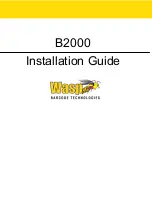
Conductive Level Controller
61F-GP-N2
5
■
Electrode Separators
F03-14 1P (for Single Pole)
F03-14 3P (for Three Poles)
Precautions
■
How to Mount Electrodes
Connecting Electrodes to Electrode Holders
Connecting One Electrode to Another
■
Application
When using electrodes in sea water or sewage, provide a sufficient
interval (normally 1 m) between the electrodes. If the sufficient inter-
val cannot be provided, employ a low-sensitivity type Floatless Level
Controller.
When taping one of the electrodes to prevent it from contacting the
other electrodes in water, do not tape the electrode entirely but leave
at least 100 mm of its end uncovered.
When the required length of the electrode is more than 1 m, use a
separator at each joint of two electrodes so as to prevent the elec-
trodes from contacting one another. (NOTE: Avoid use of the separa-
tors in dust-containing liquids.)
Usually, electrodes are used in a set of three: long, medium, and
short. Connect the short electrode to E1, the medium electrode to
E2, and the long electrode to E3. Make E3 at least 50 mm longer
than E2.
Electrodes are in actual contact with the liquid. Standard electrodes
are made of stainless steel and usable in purified water, sea water,
sewage, acid (except acetic acid, sulfuric acid, etc.) and alkaline liq-
uids, although they may corrode depending upon the temperature
and working conditions.
Note that the Conductive Level Controller 61F-GP-N2 is capable of
controlling liquids with specific resistances of up to 30 k
W
-cm when
the controller employs a type PS-3S electrode holder with the elec-
trode(s) submerged to a depth of 30 mm max.
6.5-dia.
28-dia.
41-dia.
Three 7-dia.
Electrode holder
Clamp screw
Connecting nut
1. Spin a lock nut and a spring
washer onto the electrode.
2. Fully fit the electrode into the
connecting nut attached to the
electrode holder.
3. Tighten the electrode with
the two clamp screws.
Spring washer
Lock nut
Electrode
4. Secure the connecting
nut by tightening the lock
nut and spring washer.
Electrode
Connecting nut
1. Spin a lock nut and a spring
washer onto the electrode.
3. Tighten the electrode with
the two clamp screws.
Spring washer
Lock nut
4. Secure the connecting
nut by tightening the lock
nut and spring washer.
Spring
washer
2. Fully fit the elec-
trode into the
connecting nut
attached to the
electrode holder.
Min
50mm
1m
1m
E1
E2
E3
Kind of water
Specific resistance
Applicable type
City water
5 to 10 k
W
-cm
General-purpose type
Well water
2 to 5 k
W
-cm
General-purpose type
Industrial water
5 to 15 k
W
-cm
General-purpose type
Rainwater
15 to 25 k
W
-cm
General-purpose type
Sea water
0.03 k
W
-cm
Low-sensitivity type
Sewage
0.5 to 2 k
W
-cm
Low-sensitivity type
Distilled water
100 k
W
-cm or less
High-sensitivity type
Over 100 k
W
-cm
Consult OMRON


























